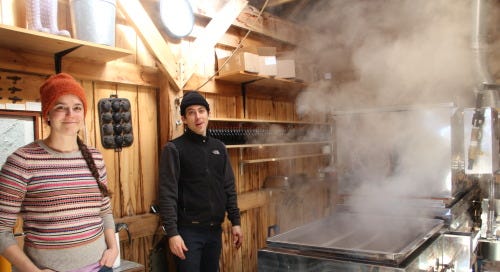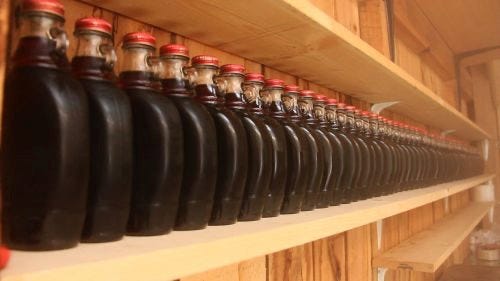When he was 25 years old, Atlanta native Doug Munroe bought 50 sloping acres in Ashe County, tucked into the northwestern-most corner of North Carolina. After working construction in Boone for eight years, Doug finally settled on his farm and began transforming the overgrown landscape that had last been logged in the 1960s. He named his spread Waterfall Farm because of the silver cascading stream on one edge of the property. He also decided to create a nursery business, growing and selling unusual ornamental trees. Most tree farmers in Ashe–and there are many–grow spruce and fir for Christmastime, but Doug wanted something different.
2018 vintage Waterfall Farms Maple Syrup, Warrensville, NC. Photos by Donna Campbell
In 2005, Munroe began experimenting with syrup production, tapping the red and sugar maple trees on his land, using the traditional bucket method for gathering the slow drip of sap. He would then build a fire and boil the sap down in his driveway. By 2009 he was hooked, reckoning an opportunity to bottle something especially delicious because of the abundance of mature maple trees on his land.
Doug traveled north to Vermont to study the finer points of syrup making. As it turned out, the maple trees that cover the hillside below Jonasee Rock, a local landmark, are not only highly productive, but the soil in which they grow is naturally sweet, hence the absence of acid-loving rhododendrons. The alkaline soil at Waterfall Farm is peppered with a metamorphic rock called amphibolite.
With a grant from the Rural Advancement Foundation, Doug soon bought a stainless steel evaporator and invited friends and family to help him build a sugar house with timber harvested from his property. To fire his evaporator he uses tulip poplar–initially harvested from his own land and now supplied by a local vendor.
As if on cue, Doug’s daughter, Wheeler, came back home in 2012 after a 16-year absence. She had studied at the North Carolina School of the Arts and the Outdoor Academy and went on to learn how to hand tool leather and make fine wood furniture in California–now an entrepreneurial venture that she shares with her husband, Michael Waldeck, whom she first met on a dance floor. When the syrup making chores are completed for the season, Wheeler and Michael, who have a studio on the property, will resume their custom handcrafts business, which is mostly conducted via the Internet. Wheeler has found a niche market for her leather tool belts designed to hold special pruning clippers and knives used by gardeners. Her best customers are horticulture enthusiasts –mostly women–she says.
Wheeler and Michael Waldeck and the evaporator.
Wheeler, now in her 30s, is a serious businesswoman. She refers to her father as “Doug,” who in turn defers to her for our discussion of the syrup making process. In 2014, Doug, now in his 60s, officially retired from the nursery business and has just published a book about the trees of Ashe County. Wheeler has become the principal driver and problem solver in the syrup business. They also raise and sell fresh trout at the farmers market in West Jefferson.
Come the new year, the syrup process begins with a fresh tap on each tree. Then production literally comes to a boil over a six-week period from January into early March. This year, the team added another 50 to 100 trees, which are connected by an elaborate system of tubing and pipes suspended on wires through the forest. Two zones–one uphill from the sugar house and another down in the holler–are connected to a vacuum system that, with the help of gravity, maximizes the sap flow. The clear liquid collects in large plastic barrels, which Michael hauls on a small tractor up to the sugar house to be emptied into a holding tank that feeds into the sap evaporator.
Wheeler is quick to explain that her goal is to double the number of trees they have tapped to a thousand within the next 10 years. Once they hit scale, she says, they will probably upgrade to a reverse osmosis system to separate the water from the concentrated sugars in the sap–a process that cuts down on the boiling time required.
It is like walking into a dense, warm cloud to enter the Munroe’s sugar house. Donna’s camera and her glasses fog up. Suddenly it feels like we are making an Ingmar Bergman film–all furtive shadow and light. Doug feeds pre-cut, fast burning poplar into the firebox as the sap boils in flat pans inside the shiny steel evaporator. Wheeler checks the boiling temperature and monitors the sugar content. We learn that this process goes on for 8 hours a day without much rest. Water drops condense on the ceiling, offering a surprise tap on the shoulder every so often.
In this happy sauna, with the scent of burning wood and a slight sugary tinge in the air, my hair is curling, my pores are opening. At one point I can barely make out Wheeler coming toward me, balancing liquid in the bowl of a long steel spoon. I taste the syrup in the making, and then I taste the clear sap from a small paper cup, which is far cleaner and brisk than any “power water” from a bottle. It is cool, clear, fresh, and probably flavored with negative ions. This is tree medicine–a holy communion, I realize, when I’m back outside feeling small on the ground, looking up into the shaggy gray trunks and expansive limbs of the maples that stand solid and leafless against a frigid blue sky on this February morning. Up above, on Three Top Mountain, the highest trees are covered with a lacy veil of white rime ice.
We are standing at 3,300 feet, in sight of both Tennessee and Virginia, and at the border–both in latitude and altitude–below which there can be no successful maple syrup making. This operation is probably the largest in North Carolina, though very small. Most other makers in the area are working at the hobby level, though Doug says making sugar was once a household commonplace in these parts and has nearly become a lost art.
This year’s syrup–which the Munroes only sell retail at the farmers’ market and to regular customers who order it by the case–is quite dark. Doug, with the confidence of a wine connoisseur, explains that sometimes the miraculous elixir from his trees will have notes of caramel, marshmallow, butterscotch, and/or vanilla. It is variable, but always sweet. They plow their profits back into the business and nothing but sap ever runs through the equipment until it is finally cleaned–exclusively with white vinegar.
Wheeler finds great satisfaction in the work that takes her into the wondrous woods she has known intimately since she was a child. When I compliment her boots, she tells me off handedly that they are the pair of rubber boots she bought with her own money when she was 11 or 12 years old. She intentionally picked a couple sizes too big so that she could wear them for a long time. “They haven’t popped a hole yet,” she says, grinning with a wry satisfaction. Wheeler has clearly grown into them.






